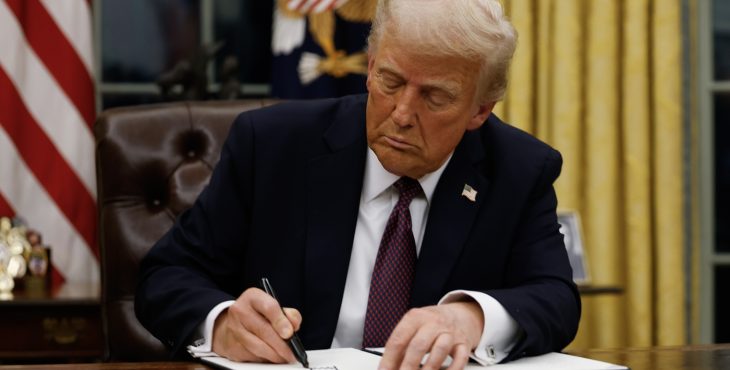The dispute—rooted in border security concerns and economic policy—has already rattled markets and strained diplomatic ties.

Here’s a timeline of key events so far:
February 2025
- February 1, 2025: President Donald Trump signed executive orders imposing a 25% tariff on all goods from Canada, with a 10% tariff specifically on Canadian energy exports, including oil and natural gas. These measures were justified by the administration as necessary to address issues related to illegal immigration and drug trafficking.
- February 3, 2025: Following negotiations, the U.S. agreed to pause the implementation of these tariffs for one month after Canada pledged to enhance border security measures and appoint a “Fentanyl Czar” to combat drug trafficking.
- February 10, 2025: President Trump announces an expansion of tariffs on steel and aluminum imports, removing exemptions granted in 2018. All steel imports will now face a 25% tariff, while aluminum tariffs will rise from 10% to 25%. These new measures are scheduled to take effect on March 12.
- February 13, 2025: Trump unveils a plan for “reciprocal tariffs,” stating that the U.S. will impose duties that mirror the rates charged by other countries on American exports. He signals that these tariffs could extend beyond Canada and Mexico to include European nations and India.
- February 25, 2025: Trump signs an executive order instructing the U.S. Commerce Department to evaluate whether additional tariffs on imported copper are necessary to protect U.S. national security.
March 2025
- March 1, 2025: Trump orders a review of tariffs on lumber and timber, citing their importance to U.S. construction and military infrastructure. This raises concerns for Canada’s forestry sector, which exports significant volumes of softwood lumber to the U.S.
- March 5, 2025: Following discussions with the CEOs of Ford, General Motors, and Stellantis, Trump grants a one-month exemption on new tariffs impacting auto-related goods imported from Canada and Mexico.
- March 6, 2025: Trump postpones certain planned tariffs on Mexican and Canadian imports until April 2, citing progress on border security efforts. While Mexico secures a temporary reprieve, Canada remains under economic pressure as other trade measures remain in place.
- March 10, 2025: Ontario Premier Doug Ford announces a 25% surcharge on electricity exports to U.S. states Michigan, Minnesota, and New York, in retaliation for U.S. tariffs on Canadian metals.
- China retaliates against Trump’s tariff hikes by raising duties on key U.S. agricultural exports, including pork, soybeans, and beef. The move sends U.S. stock markets lower, as investors express concerns about the impact of escalating trade disputes.
- March 11: President Trump threatens to double tariffs on Canadian steel and aluminum to 50% in response to Ontario’s electricity surcharge.
- Following discussions between Ontario Premier Doug Ford and U.S. Commerce Secretary Howard Lutnick, Ontario suspends the 25% electricity surcharge. Consequently, President Trump withdraws the threat to double tariffs on Canadian metals.
- March 12, 2025: Trump’s new tariffs on Canadian steel and aluminum take effect, despite prior threats to double them to 50%. Canada immediately responds with tariffs on $29.8 billion worth of U.S. goods, targeting key industries.
- The European Union joins the trade dispute, imposing retaliatory tariffs on U.S. industrial and agricultural products, including textiles, home appliances, and food exports.
- March 14: Mark Carney is sworn in as Canada’s 24th Prime Minister, emphasizing the protection of Canadian workers and households against U.S. trade actions.
- March 18, 2025: Prime Minister Mark Carney announces a $12-billion federal relief package aimed at supporting Canadian industries hit hardest by the U.S. tariffs, including steel, aluminum, forestry, and agriculture. The package includes loan guarantees, wage subsidies, and export diversification programs.
- March 20, 2025: The World Trade Organization confirms it has received formal complaints from both Canada and the European Union over the latest round of U.S. tariffs, triggering a dispute resolution process.
- March 22, 2025: U.S. farmers stage protests in several midwestern states following steep declines in pork and soybean exports to China. Several Republican governors express concern over the widening trade conflict’s impact on rural economies.
- March 25, 2025: Canadian Deputy Prime Minister Chrystia Freeland meets with U.S. Treasury Secretary Larry Kudlow in Washington. Talks are described as “constructive but inconclusive,” with both sides agreeing to reconvene in early April.
- March 27, 2025: The U.S. Trade Representative’s office announces preliminary investigations into Canadian subsidies in the green energy sector, signalling potential new duties on Canadian solar panels and wind turbine components.
- March 28, 2025: Mexico expresses frustration at being caught in the crossfire of the U.S.-Canada trade dispute, with President Claudia Sheinbaum urging a trilateral summit under the USMCA framework to defuse tensions and restore regional economic stability.
- April 1, 2025: Canada imposes new retaliatory tariffs on U.S. liquefied natural gas (LNG), bourbon, and processed foods, saying the goal is to “maximize political visibility in key U.S. swing states.” The Canadian dollar dips as markets brace for a prolonged trade battle.
- April 9, 2025: President Trump announces a 90-day suspension of his new “reciprocal” tariffs on most U.S. trading partners—but not on Canada or Mexico. The White House confirms that existing 25% tariffs on Canadian cars, steel, and aluminum remain in place.
That same day, Ottawa escalates its own response by imposing tariffs on U.S.-made vehicles. Unlike the U.S. duties, Canada’s measures exclude auto parts and Mexican-made vehicles and components.
Trump also raises tariffs on Chinese goods to 125%, citing Beijing’s “lack of respect.” China responds with an 84% tariff on U.S. imports, intensifying global trade tensions.
To be continued…
Canada-US trade war Donald Trump tariffs timeline trade war Trump tariffs
Last modified: April 9, 2025










